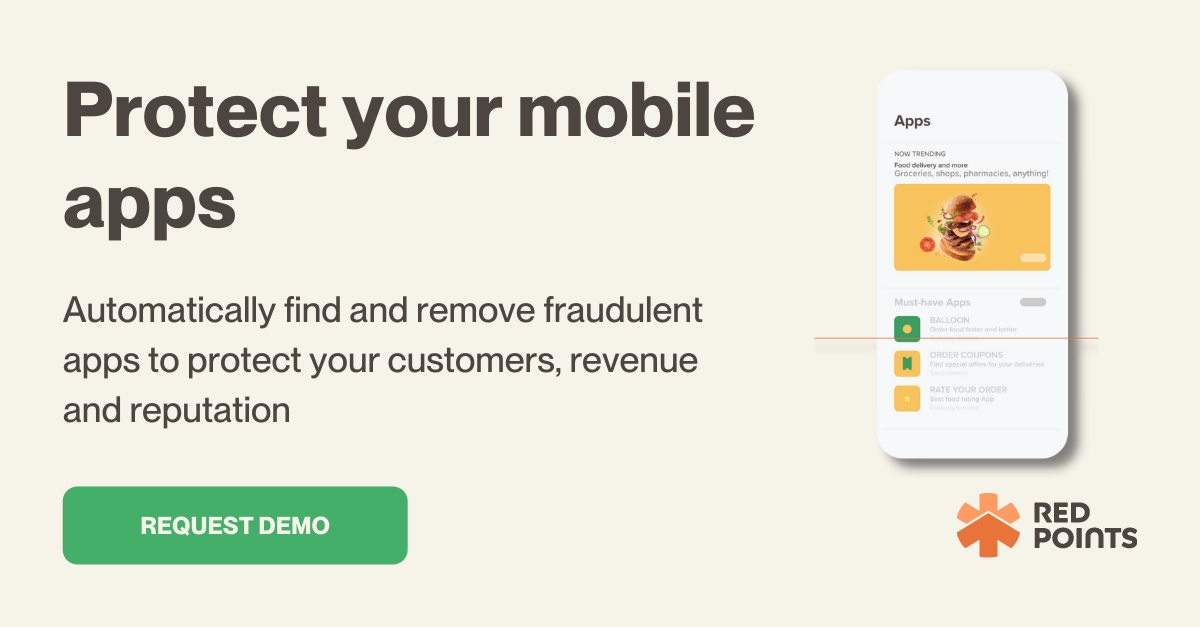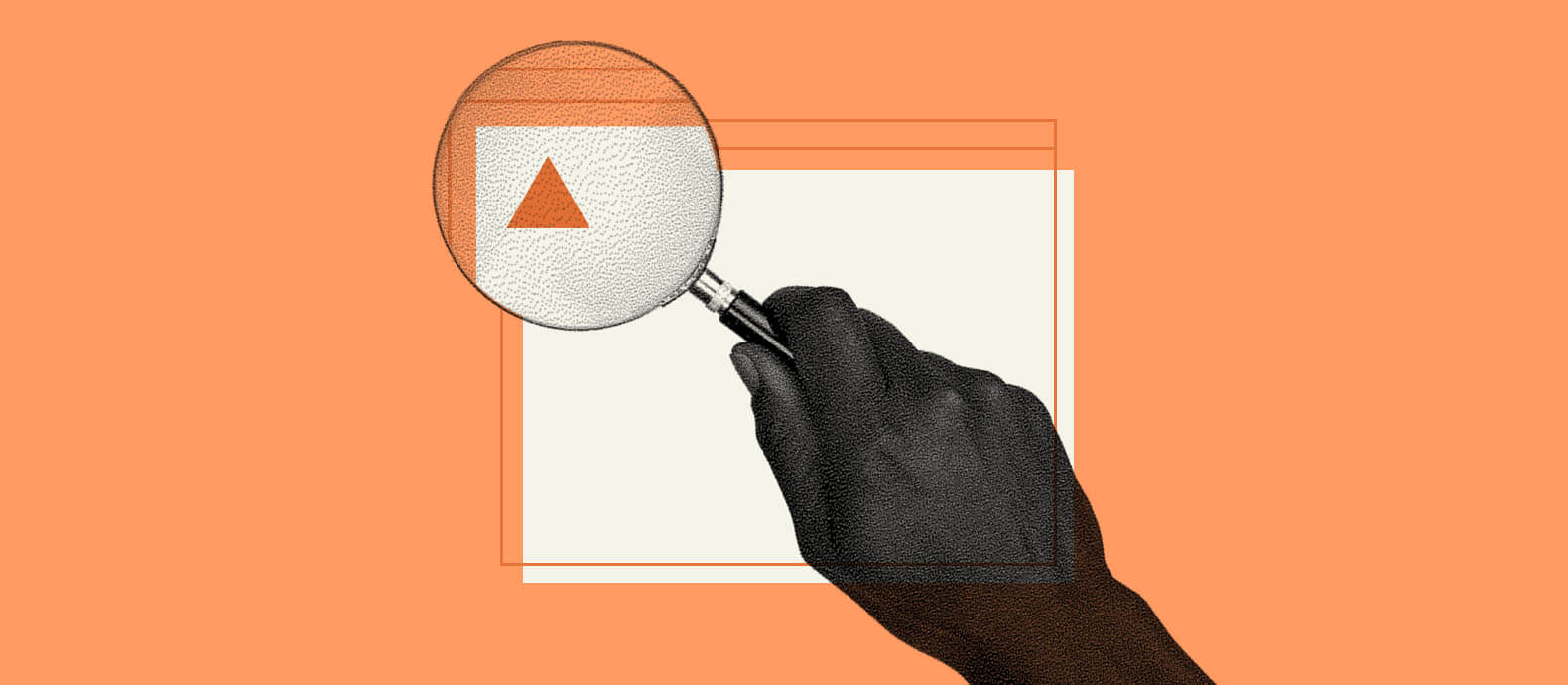It’s estimated that in 2023, more than 600 million fake apps were downloaded onto people’s phones, tablets, and other devices. This shocking statistic reflects the surge of scammers and frauds who are active online, and just how many unsuspecting customers can fall foul of their tactics. On the surface, it might seem like downloading a fake app is simply a nuisance that’s easily deleted. But the truth is, that the fraudsters who run these apps can cause considerable damage to legitimate brands who use apps to connect with, serve, and advertise to their customers.
In this blog, we will explore:
- How to spot fake apps
- How fake apps are produced
- How fake apps are distributed
- Why 3rd party app stores represent a security threat for brands
- How Red Points can help you spot fake apps

How to spot fake apps
So, how do you tell a fake app from a real one? And how can you detect fake versions of your own app online? Here are a few key indicators that you should keep an eye out for:
- Mistakes
Fake apps will often contain a number of mistakes in the literature or the user interface (UI).
Check whether there are any typos or mistakes in grammar. This is usually a key indicator that the app is fake and the content has been hastily typed up by a scammer who hasn’t paid attention to the details.
- Reviews
Read the reviews. By checking the reviews you will be able to see whether users have complained about the app being fake. Alternatively, if all the reviews sound too good to be true this is also indication that the app is probably fake. Fraudulent app creators will often try to boost the apparent legitimacy of their app by writing lots of fake positive reviews.
- Number of downloads
In general, legitimately popular apps will have thousands or even millions of downloads. If you see an app that appears to be popular but in fact only has a few hundred reviews, this is an indication that it might be a fake.
- The icon
Designers of fake mobile apps will sometimes choose an app icon that looks very similar to the icon of a legitimate brand. Fake game apps will often mimic the icons of popular games hoping that users will click on their icon by mistake.
- The permission agreement
Review the permission agreement before you download it. It’s tempting to skip through the T&Cs. But fake apps may sometimes ask for authorizations that are not necessary. This is an easy one to miss because most people won’t read the fine print.
- The release date
The release date is sometimes a subtle clue as to whether an app is fraudulent. Fake apps might have a very recent release. When this information is seen alongside very high download numbers it should raise suspicions. Usually, a real app will need to have been on the marketplace for a while for it to have high download numbers.
How are fake apps produced
Mod APK
MOD APK refers to a modified application. APK stands for Android Package Kit and is a common way scammers are producing fake apps to bypass security measures and mislead users. Modded APKs or Mod APKs are reworked copies of original mobile apps used to provide users with new or improved features.
Scammers can target certain brands and users by producing fake apps via modded APKs. These customized applications can then be used to infect devices and steal information and funds. Pirates can also create Mod APKs for different reasons such as to resell the app or just to give the software away for free, sometimes including malware.
Mod IPA
Mod IPA is an iOS App Store Package. Similar to a modded APK, a mod IPA is an application archive file, containing an app that can be used to produce fake apps capable of distributing malware and phishing attacks.
How are fake apps distributed
Two of the key ways fake apps are distributed are via phishing scams and third-party app stores.
Phishing scams
Users may stumble upon a fake app by clicking on an illigitimate webpage. This is one of the most common ways scammers direct users towards their fake apps. Once users have clicked on the dodgy link, scammers can distribute their fake apps and start to steal sensitive information to use for criminal purposes.
Third-party app stores
Third-party app stores are often a more agreeable ecosystem for fake apps and scammers. The main app stores, like Apple’s app store and the Google Play Store, have very robust and well-funded security measures in place to limit the amount of fake apps. On the other hand, third-party app stores may often have less security and compliance measures, making it easier for scammers to distribute their fake apps and target specific users.
Why third-party app stores represent a security threat for brands
Outside of Apple’s App Store, the Google Play Store, and Amazon’s App Store, there exists a whole host of third-party app stores. Many of these have smaller ecosystems but are targeted toward promoting specific kinds of apps or attracting a particular subset of users. While these third-party app stores may seem like a valuable opportunity for brands and consumers, they also represent an increased security threat because they attract a variety of fake apps.
For many years Apple has blocked third-party app stores from operating on its devices. To protect their devices and their users, they have always funneled apps through their own App Store where app owners have had to abide by their guidelines. However, since the EU’s Digital Markets Act entered into force on November 1, 2022, Apple has been forced to change its stance.
This new EU legislation requires Apple to allow European users to download apps from alternative and third-party app stores. This is supposed to implement ‘rules for digital gatekeepers to ensure open markets’.
Now, as of 2024, Apple has adapted its rules to meet Brussels laws, meaning EU customers can download apps without going through its own store.
While their revenue may suffer, Apple’s main complaint about the changes has centered on security. This legislation will likely represent a security threat for brands because it may increase the amount of fake apps on Apple devices.
The app store has always played a significant role in ensuring the integrity and security of iOS devices because every app must follow Apple’s guidelines and pass a robust review process. However, this new trend of ‘sideloading’ (allowing apps to be loaded onto devices from sources not approved by Apple or other device owners) represents a potential security threat for brands and consumers.
A report put out by Apple last year stated that “Allowing sideloading would degrade the security of the iOS platform and expose users to serious security risks not only on third-party app stores but also on the App Store”. But later Phil Schiller, the executive in charge of Apple’s App Store, said, “The changes we’re announcing… comply with the Digital Markets Act’s requirements in the European Union while helping to protect EU users from the unavoidable increased privacy and security threats this regulation brings.”
Another concern for brands is that the proliferation of third-party app stores on iOS and Android devices could increase the threat of brand impersonation. Third-party app stores will likely be more habitable for counterfeit mobile apps because they have less robust security measures and guidelines.
It will be harder for users and competitors to spot these fake apps which may confuse customers. If these fake apps perform poorly or install malware, this will degrade the reputation of legitimate brands, reduce the security of devices, and cause consumers to lose trust in the whole system.
How Red Points can help you spot fake apps
Monitoring & Detection
Fake apps can be found all over the web and across a wide variety of app marketplaces, both mainstream and alternative. That’s why Red Points’ service uses AI automation to monitor official and third-party app stores every day. These systems are powered by machine learning, so they continually become more precise and powerful with every search. This means we can find fake apps and start taking them down as quickly as possible.
Validation & Enforcement
After our monitoring tool identifies a fake app, we hand control back over to the brands. You will get to control the validation and enforcement by enabling automated rules that let us take down fake apps on your behalf. You will also be able to manually validate and request takedowns of fake apps that are particularly damaging to your app.
Takedown & Follow-through
Following validation and confirmation of infringement, Red Points will begin to pursue these fake apps. Red Points will handle the entire takedown process to ensure that all traces of the fake apps are removed. We will fill out the forms, submit the evidence, and contact all relevant authorities.
After the takedowns have been performed, Red Points will allow brands to measure the impact of enforcement through performance dashboards and tailored reports. Ultimately, this will enable you to calculate the economic impact of the process and see how much you have saved by pursuing and removing these fake apps.
What’s next
Fake apps are everywhere. If you are a brand looking to grow your revenue and reputation, you have to be on the lookout for fake apps because they have the potential to ruin your future plans. From degrading your customer loyalty to damaging income streams and infringing on your property rights, it’s an issue that only grows if left alone without legitimate brands taking action.
Once you know how to spot fake apps you need to act fast to take them down. This process will be a lot quicker and more effective if you work with an anti-piracy service like Red Points. In fact, manually scanning the internet not only takes huge amounts of time, manpower, and money. It’s also virtually impossible to know all the places where a scammer might be acting under the guise of your brand name.
To learn more about how Red Points can protect you from fake apps and free you to safely grow your app, talk to one of our experts and request a demo today.






